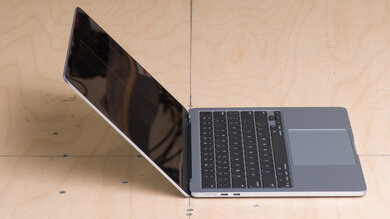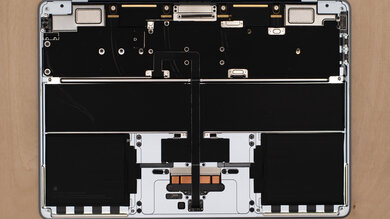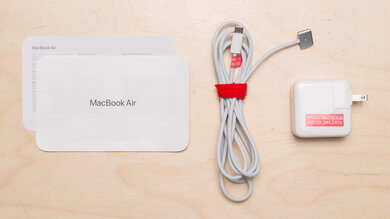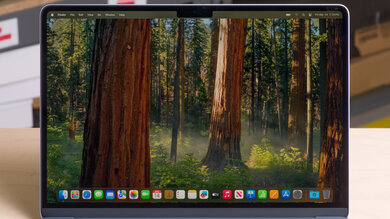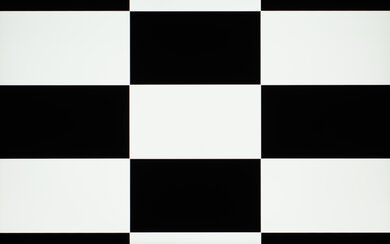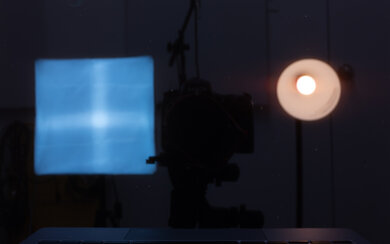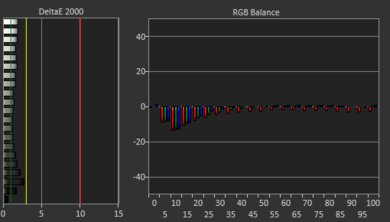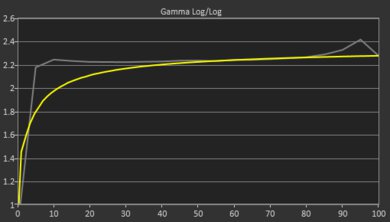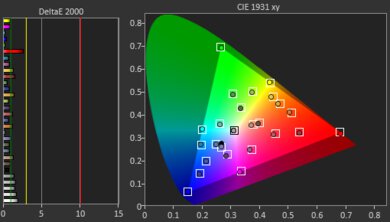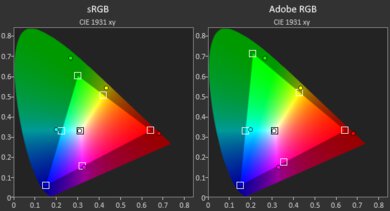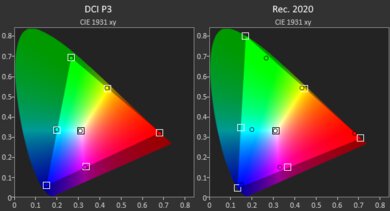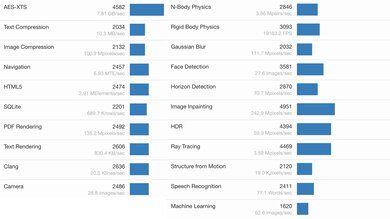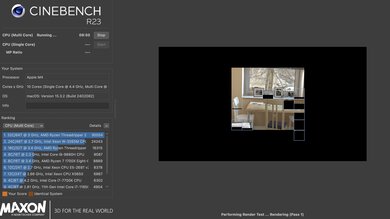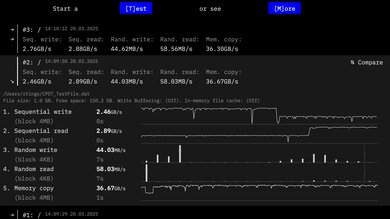The Apple MacBook Air 13 (M4, 2025) is a premium ultraportable laptop. It replaces the M3 Apple MacBook Air 13 (2024). The 2025 model brings a few upgrades, including the M4 SoC, a 12MP webcam with Center Stage support, and Thunderbolt 4 video output, allowing you to connect up to two 6k @ 60Hz in addition to the built-in Retina screen. Memory and storage configuration max out at 32GB and 2TB, respectively. Ports include two USB-Cs, a MagSafe charging port, and a 3.5 mm headphone jack. This laptop is available in four colors: Silver, Sky Blue, Midnight, and Starlight.
See our unit's specifications and the available configuration options in the Differences Between Variants section.
Our Verdict
The Apple MacBook Air 13 M4 is excellent for school use. It's a very compact laptop with an exceptionally sturdy build, and its battery lasts easily through a typical day of light use. The overall user experience is excellent, as it has a sharp, bright display, a tactile keyboard, and a large, easy-to-use haptic touchpad. Performance is great; its M4 SoC can easily handle most student workloads, like text processing, web browsing, and video playback. Plus, this is a fanless laptop, so you won't have to worry about causing noise in a quiet classroom or library. You can do more intensive tasks like 3D graphics, but you might not get the smoothest experience, depending on the complexity of your project. Unfortunately, it only has two USB-C ports, so a dongle may be necessary if you want to connect multiple peripherals.
Sturdy build and compact design.
All-day battery life.
Sharp, bright display.
Tactile keyboard, responsive touchpad.
Fanless design.
Display still limited to 60Hz.
Limited port selection.
The Apple MacBook Air 13 M4 isn't ideal for gaming. Its M4 SoC can only handle light, older, or highly optimized (for Apple silicon) games, and even then, you might have to play with fairly low graphical settings to get smooth gameplay. Also, many games lack macOS support or don't run natively on an ARM-based processor, so performance can vary a lot from one game to another. Unfortunately, you can only get this laptop with a 60Hz refresh rate, and its response time is slow, causing noticeable ghosting in fast-moving scenes.
Fanless design.
Fast storage speeds.
60Hz display with slow response time, no VRR.
M4 SoC struggles in highly demanding workloads.
Few games optimized for Apple silicon.
Soldered RAM and storage.
Limited port selection.
The Apple MacBook Air 13 M4 is great for media consumption. It has a compact design that makes it easy to carry, and its battery life is amazing at nearly 12 hours of video playback. The speakers get reasonably loud and produce a well-balanced sound with a decent amount of bass. The display is sharp, bright, and color-accurate; however, it isn't ideal for dark room viewing, as its low contrast makes blacks look gray in dim settings. There's no touch input support, which might be disappointing if you're looking for a convertible that can give you a more tablet-like experience when viewing content.
Sturdy build and compact design.
All-day battery life.
Sharp, bright display.
Blacks look gray in dim settings.
The Apple MacBook Air 13 M4 isn't ideal for use as a workstation. Its M4 SoC can only handle light to moderately intensive tasks. Plus, you can only get up to 32GB of soldered RAM, which might not be enough for some workloads. Video editing is possible, thanks to the chip's media engines, but know that you might experience stutters if you work with a lot of high-resolution footage. Color-correction isn't a problem, as the display has full DCI P3 coverage and outstanding factory calibration. There's some thermal throttling under load, and unfortunately, there are only two USB 4/Thunderbolt 4 ports.
Dedicated video decoders and encoders.
Display is suitable for color-critical work.
Fanless design.
Fast storage speeds.
M4 SoC struggles in highly demanding workloads.
Soldered RAM and storage.
Limited port selection.
The Apple MacBook Air 13 M4 is great for business use. It has an exceptionally sturdy build, a compact design, and a battery that lasts easily through a typical workday, making it well suited for those who travel a lot for work. Its M4 SoC can handle most productivity tasks, like text formatting, spreadsheets, and presentations. You can even do some photo and light video editing, which is great if you own a small business and need to do a little bit of everything. The user experience is excellent; you get a sharp, bright display, a tactile keyboard, a large haptic touchpad, and an excellent 1080p webcam. Its main flaw is its limited port selection, which comprises only two USB-Cs, so you might need a dongle or dock if you want to connect multiple peripherals or displays.
Sturdy build and compact design.
All-day battery life.
Sharp, bright display.
Tactile keyboard, responsive touchpad.
Excellent 1080p webcam.
Display still limited to 60Hz.
Limited port selection.
Changelog
- Updated Jul 21, 2025:
We've added a link to the newly reviewed Framework Laptop (2025) in the Serviceability section of the review.
- Updated May 07, 2025: We've updated this review to Test Bench 0.8.3, which removes the viewing angle tests and adds a GPU Total Graphics Power comparison in the GPU section. The Pen Input test in the Extra Features section has also changed, as it now shows whether the laptop supports pen input rather than the inclusion of a stylus in the box. See the changelog for more details.
- Updated Apr 02, 2025: Review published.
- Updated Mar 28, 2025: Early access published.
Differences Between Sizes And Variants
We tested the base configuration of the Apple MacBook Air 13 with a 10-core CPU/8-core GPU M4 SoC, 16GB of RAM, and 256GB of storage. The SoC, memory, and storage are configurable; the available options are in the table below.
SCREEN
- 13.6" IPS 2560 x 1664 60Hz
SoC
- M4 SoC with 10-core CPU and 8-core GPU
- M4 SoC with 10-core CPU and 10-core GPU
MEMORY
- 16GB LP-DDR5x 7500MHz
- 24GB LP-DDR5x 7500MHz
- 32GB LP-DDR5x 7500MHz
STORAGE
- 256GB
- 512GB
- 1TB
- 2TB
COLOR
- Midnight
- Starlight
- Sky Blue
- Silver
See our unit’s label.
Popular Laptop Comparisons
The Apple MacBook Air 13 M4 is one of the best ultraportable laptops on the market. Its build quality, as well as the quality of its touchpad and speakers, is class-leading. Apple's M4 SoC has among the fastest single-thread performance compared to other current-gen chips, and while its multi-thread performance doesn't stand out as much, it's nonetheless very impressive considering the lack of active cooling. Its battery life is a little behind that of some Windows laptops, like the Microsoft Surface Laptop 7th Edition 15 (2024), but it's still among the best you can get from an ultraportable. Apple's Retina display is falling behind, though, as many premium ultraportables now come with a 120Hz display to provide a smoother desktop experience, like the aforementioned Surface Laptop, the HP OmniBook Ultra Flip 14 (2024), and the Lenovo ThinkPad X9 15 Aura Edition (2025).
For more options, check out our recommendations for the best lightweight laptops, the best laptops for college, and the best 13- and 14-inch laptops.
While the Apple MacBook Pro 14 (2024) is a much better device than the Apple MacBook Air 13 (M4, 2025), they aren't intended for the same audience. The Air is an ultraportable designed for light to moderately intensive workloads, while the Pro is a much more powerful device aimed at professionals, like content creators. The Pro has a nicer Mini LED display, more ports, and longer battery life. If you want the niceties of the Pro model but don't need the extra processing power, know that the Pro is also available with the base M4 SoC.
The Apple MacBook Air 13 (M4, 2025) and the Microsoft Surface Laptop 7th Edition 15 (2024) are both premium ultraportables designed for general productivity. The choice comes down to what you care about most. The Surface Laptop has a brighter 120Hz display, a wider port selection, and longer battery life, while the MacBook Air has a larger touchpad and better-sounding speakers. If you're considering the Surface Laptop, know that it uses an ARM-based SoC, meaning some programs might not work or run poorly through emulation. Apple transitioned to its in-house SoC sooner, so app compatibility is typically better on the MacBook Air.
The ASUS Zenbook A14 UX3407 (2025) and the Apple MacBook Air 13 (M4, 2025) are both ultraportable laptops designed for general productivity. The Zenbook A14 has a much better battery life, but the MacBook Air is otherwise a better laptop overall, providing a more premium user experience with its brighter, sharper display, easier-to-use haptic touchpad, superior webcam, and fuller sounding speakers. Performance-wise, the MacBook Air's M4 SoC has much better single-thread performance than the Zenbook A14's Qualcomm SoC, making the system feel snappier and more responsive.
The Apple MacBook Air 13 (M4, 2025) is a newer version of the Apple MacBook Air 13 (2024). The 2025 model is a relatively minor upgrade, bringing increased performance and a new 12MP camera with Center Stage support. It also gets Thunderbolt 4 video output, allowing you to connect up to two 6k @ 60Hz displays while still using the built-in screen, whereas the older M3 model can only output to two external displays (one at a 6k resolution and the other at 5k) with the lid closed.
Test Results
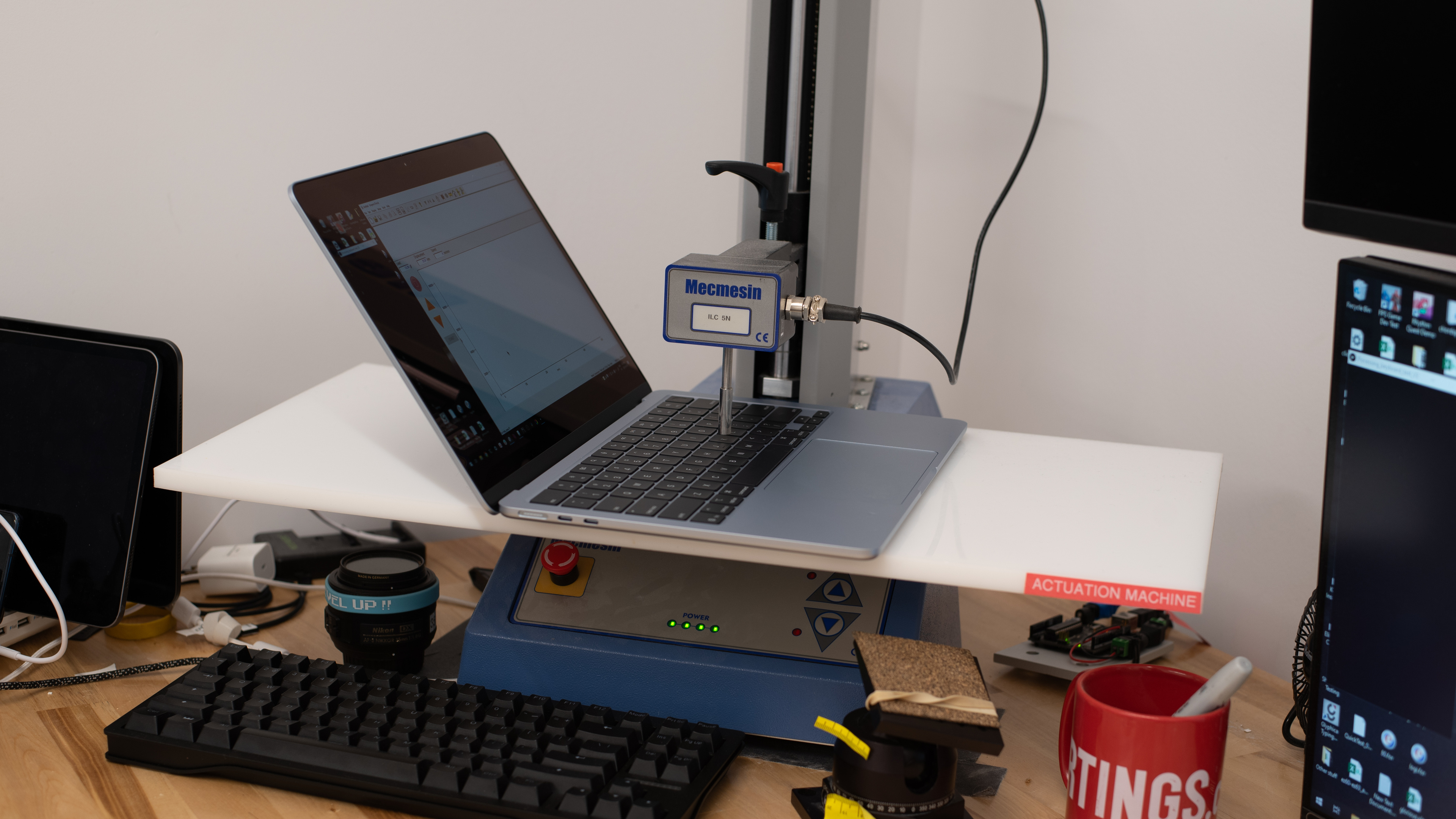
The Apple MacBook Air 13 M4 is available in a Midnight, Silver, Starlight, and Sky Blue colorway. See the bottom of the laptop.
The Apple MacBook Air 13 M4's build quality is outstanding. Its full-aluminum chassis feels very sturdy, exhibiting little to no flex on the lid and keyboard deck. The finish is fairly resistant to scratches. Fingerprints and smudges aren't an issue on the lighter color models—they'll show more on the Midnight model, a typical downside of dark-color finishes. The feet feel solid and stick firmly to the bottom.
Accessing the Apple MacBook Air 13 M4's internals isn't overly difficult, but it may take some time and effort if you've never opened a MacBook before. You need to remove four P5 screws, then use a prying tool to push the bottom panel downward before pulling it off. Unfortunately, most components aren't user-replaceable.
Check out the Framework Laptop 13 (2025) if you want an easily repairable and upgradeable ultraportable laptop.
The Apple MacBook Air 13 M4's QHD+ display looks very sharp. There are sharper screens on the market, like some Windows laptops and even Apple's own Apple MacBook Pro 14 (2024); however, the difference is hard to notice at typical viewing distances. The 16:10 aspect ratio is well-suited for productivity; it gives you more vertical space than a standard 16:9 screen, allowing you to see more information at once when reading a document, so you don't have to scroll as much. The downside is that you'll almost always have black bars at the top and bottom when watching standard 16:9 videos.
Regarding screen real estate, 13.6-inch is on the smaller side. You can work with two windows side by side, but it does feel a little cramped. For the best multi-window experience, it's best to go up to the Apple MacBook Air 15 (M4, 2025). See the differences between the two sizes in the photos below.
The Apple MacBook Air 13 M4's display is bright enough for use in most settings. Outdoor use is possible, but you may have some trouble with visibility in direct sunlight, especially dark-color content. It gets very dim at the lowest brightness setting, which is great for dark room viewing as it causes less eye strain.
The display's reflection handling is outstanding. Its glossy finish mainly struggles with bright light sources, like a lamp or open window during the day. These reflections are visible when viewing bright-color content with the screen at max brightness, but they aren't overly distracting.
The display's accuracy is outstanding out of the box. Most white balance and color inaccuracies are extremely minor and hard to spot with the naked eye. The color temperature is a tad on the cooler side, giving the image a slight, almost imperceptible blue-ish tint. The gamma follows the curve well at mid-brightness, but it's too high in very dark and very bright scenes, making them look too dark.
The retina display has an outstanding color gamut. It has full sRGB and DCI P3 coverage, the color spaces used in most SDR and HDR content, respectively. Its Adobe RGB coverage is excellent, but it might not be good enough for some photography professionals, as it's missing the saturated greens that define Adobe RGB.
The Apple MacBook Air 13 M4 has a great keyboard. This is the same keyboard as the M2 and M3 MacBook Airs, so if you already have experience with those models, you know what to expect. The typing experience is very good overall; the keyboard has a spacious layout that's easy to get used to, stable keys, and a good amount of tactility. A common complaint is that the key travel is quite short, and when combined with the keyboard deck's rigidity, it can feel like tapping on a hard surface, leading to fatigue. This is especially a problem if you're a heavy typer. The backlight is white and shines uniformly through the legends—you can adjust the brightness via the control panel or the system settings.
As for the amount of space on the deck to rest your hands while typing, the 13-inch model naturally has less space than the Apple MacBook Air 15 (M4, 2025). This means that if you have large hands, your wrists might hang at the edge of the deck, causing some discomfort, as the laptop's sharp edges can dig into the wrists after a while. If this worries you, then consider going up to the 15-inch model.
The Apple MacBook Air 13 M4 has an outstanding touchpad. It's large, smooth, and responsive to all movements and gestures. Palm rejection works as intended, and there aren't any issues with actions like dragging and dropping. This is a haptic touchpad, so you can click anywhere on the touchpad. The haptic engine simulates clicks well, providing clear tactile feedback. The clicks are quiet and shouldn't be bothersome in noise-sensitive settings like classrooms or libraries.
The speakers get reasonably loud with minimal compression artifacts or distortion at high volume levels. They sound clear and natural, with a decent amount of bass.
Here's a comparison between the 13-inch and 15-inch MacBook Airs' speakers.
The Apple MacBook Air 13 M4 has an excellent webcam. The image looks sharp, detailed, and natural, with very little noticeable noise. Although the video resolution is the same as the Apple MacBook Air 13 (2024), this M4 model has a new 12MP sensor with support for Center Stage, a feature that keeps you in the frame when you move around. See more info about it on Apple's website. The microphone is also excellent; voices sound loud and clear, with almost no background noise.
The Apple MacBook Air 13 M4 has a very limited port selection. Both USB-Cs support USB 4/Thunderbolt 4 data transfer speed of up to 40Gbps, DisplayPort 1.4, and charging. The most notable change in this M4 model is its external display support; it can now support up to two 6k @ 60Hz displays while using the built-in screen.
We can't confirm which wireless adapter the Apple MacBook Air 13 M4 uses. Wi-Fi 6E gives access to the 6GHz band, providing faster speeds, lower latency, and less signal interference than previous Wi-Fi standards. However, you need a router that supports Wi-Fi 6E to benefit from these features. See our recommendations for the best routers if you want to upgrade your home's Wi-Fi.
The Apple MacBook Air 13 M4 is available with the following SoCs:
- M4 SoC with 10-core CPU and 8-core GPU
- M4 SoC with 10-core CPU and 10-core GPU
The M4 SoC is a straight upgrade from its M3 predecessor, adding two more efficiency cores and increasing the memory bandwidth from 100GB/s to 120GB/s. It has the same media encoders and decoders as the M3, as well as hardware-accelerated ray tracing support, an AV1 decoder, and a 16-core neural engine. The M4 chip can handle general productivity tasks like text processing, web browsing, and video playback, as well as some intensive workloads like programming and photo editing. Video editing is possible, thanks to the dedicated media engines, but you might experience some stutters if the material is extremely complex. Also, keep in mind that this is a fanless laptop that suffers from some thermal throttling, so completion times might be a little inconsistent, depending on the workload. The only difference between the two SoCs is on the graphical side, with the higher-end chip sporting two additional GPU cores.
The Apple MacBook Air 13 M4 is available with an 8-core or 10-core GPU M4 SoC. The M4 SoC's GPU is primarily designed for general productivity tasks but can handle some light gaming. There isn't a huge difference between the 8- and 10-core variant performance-wise, so unless you plan on performing graphically intensive tasks and want as smooth an experience as possible, the base 8-core variant is likely adequate for most people.
You can configure this laptop with 16GB, 24GB, or 32GB of memory. The RAM isn't user-replaceable.
You can configure the Apple MacBook Air 13 M4 with 256GB, 512GB, 1TB, or 2TB of storage. The storage isn't user-replaceable.
The Apple MacBook Air 13 M4 scores well in the Geekbench 5 benchmarks. Compared to its M3 predecessor, the M4 chip is roughly 13% faster in single-thread and 19% faster in multi-threaded workloads. This level of performance is more than adequate for general productivity tasks like web browsing, text processing, and video playback. Heavy multitasking isn't a problem unless the applications involved are extremely demanding. The GPU (eight cores) is also faster, about 18% over its M3 predecessor. This performance level, while impressive for an integrated GPU, is still relatively weak compared to current-gen entry-level discrete GPUs. If you need to perform GPU-intensive computing tasks, it's best to get an Apple MacBook Pro 14 (2024) with more GPU cores or a Windows laptop with a dedicated GPU.
Below are additional benchmark scores in Geekbench 6 in case you're more familiar with those numbers:
- CPU Single-thread: 3,720
- GPU Multi-thread: 14,882
- GPU Compute: 48,576
The M4 SoC scores well in the Cinebench R23 benchmark. Again, the single-thread performance is well ahead of other current-gen CPUs. Its multi-thread performance is within the same ballpark as competing SoCs, like Intel's Lunar Lake chips, but remember that this is a fanless laptop, which makes it all the more impressive. This performance level is adequate for light to moderately intensive tasks. If you need even better performance, it's best to get an Apple MacBook Pro 14 (2024) or a Windows laptop with an H- or HX-series CPU.
Here are additional benchmark numbers from Cinebench 2024 in case you're more familiar with them:
- Single-thread: 171
- Multi-thread: 727
The Apple MacBook Air 13 M4 performs quite well in Blender, as the GPU renders images in a reasonable amount of time. However, keep in mind that the GPU throttles under load, so completion time can vary depending on the workload. If you want the smoothest experience or the fastest render times, it's best to get an Apple MacBook Pro with more GPU cores or a Windows laptop with an NVIDIA dedicated GPU that supports Optix.
The M4 SoC with eight GPU cores performs quite well for an integrated GPU, scoring in the same ballpark as an NVIDIA GeForce GTX 1650 (mobile), an entry-level discrete GPU from 2019. This performance level will allow you to play some lighter, older, or well-optimized (for Apple silicon) games, but you'll have to play with relatively low settings to get playable frame rates. Keep in mind that gaming performance will also vary a lot depending on the game since most games haven't been optimized for Apple silicon and need to run through Rosetta 2.
Borderlands 3 runs poorly on the Apple MacBook Air 13 M4 at 1080p. While the frametime is surprisingly consistent for an ultraportable laptop with a low-power SoC, the gameplay is still a little too choppy for a good gaming experience, even with low graphical settings. The M4 SoC with ten GPU cores will only perform slightly better.
The M4 SoC can run Civilization VI and other similar strategy titles pretty smoothly with just a few tweaks in the settings. The turn time is decent—not class-leading but still pretty impressive for a low-power SoC.
Counter-Strike 2 doesn't run on macOS, as Valve has discontinued support.
Shadow of the Tomb Raider is playable at 1080p with low graphical settings, but you'll likely experience some stutters in busy scenes. The M4 SoC with ten GPU cores will only perform slightly better. The large frametime spikes are scene changes and aren't representative of the performance.
The keyboard gets hot under load around the letter T and may cause some discomfort. The bottom of the laptop doesn't get as hot, reaching a temperature of 41.5 °C (106.7 °F). There's no fan noise since this is a fanless device.
The Apple MacBook Air 13 M4 comes with macOS Sequoia. There's no additional pre-installed application other than the ones that typically come with macOS. See more information about macOS Sequoia on Apple's website.
There's a fingerprint sensor built into the power button. You can use it to log in quickly, authorize purchases in the Apple App Store, and auto-fill saved passwords on supported websites.



